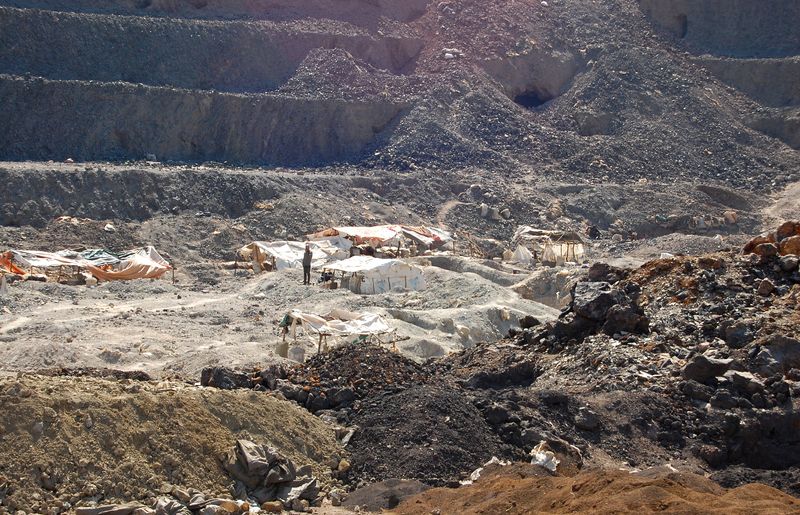
© Reuters. Artisanal miners work at the Tilwizembe, a former industrial copper-cobalt mine, outside of Kolwezi, the capital city of Lualaba Province in the south of the Democratic Republic of the Congo, June 11, 2016. REUTERS/Aaron Ross/File Photo
F
+0.75%
Add to/Remove from Watchlist
Add to Watchlist
Add Position
Position added successfully to:
Please name your holdings portfolio
Type:
BUY
SELL
Date:
Amount:
Price
Point Value:
Leverage:
1:1
1:10
1:25
1:50
1:100
1:200
1:400
1:500
1:1000
Commission:
Create New Watchlist
Create
Create a new holdings portfolio
Add
Create
+ Add another position
Close
GLNCY
+0.95%
Add to/Remove from Watchlist
Add to Watchlist
Add Position
Position added successfully to:
Please name your holdings portfolio
Type:
BUY
SELL
Date:
Amount:
Price
Point Value:
Leverage:
1:1
1:10
1:25
1:50
1:100
1:200
1:400
1:500
1:1000
Commission:
Create New Watchlist
Create
Create a new holdings portfolio
Add
Create
+ Add another position
Close
(Reuters) – A fall in the price of cobalt, a silvery-blue metal used in electric vehicle (EV) batteries, electronics and the defence sector, has yet to deter many Chinese-owned and other mines from expanding or maintaining output.
Most of the expansions are in the Democratic Republic of Congo (DRC), the dominant producer with nearly 70% of global supply, but Indonesia is a growth area.
Some projects have been delayed because of the weak prices and major producer Glencore (OTC:GLNCY) has said it may trim output.
Below are the status of current and future cobalt operations.
DELAYS, POSSIBLE CUTS
Glencore’s CEO said in August the company had stockpiled material and would consider cutting production in response to weak prices, although so far production has remained steady.
The company owns the Mutanda copper-cobalt operation in Congo, the world’s biggest cobalt mine, which along with other operations pumped 32,500 metric tonnes of cobalt in 2023 to end-September, largely unchanged from last year.
Chemaf SA was expanding its Etoile open cast copper-cobalt mine in Congo and building a new one, Mutoshi, before putting itself up for sale in response to high debt, inflation and low cobalt prices.
The two operations were due to produce 4,000 and 16,000 tons of cobalt annually respectively and were 85% complete, but analysts expect the launch to be delayed.
Jervois Global in March suspended final construction of its Idaho cobalt operations, which would be the only U.S. primary cobalt mine, citing weak prices. It was expected to produce 2,000 metric tons a year.
CHINESE COMPANIES IN DEMOCRATIC REPUBLIC OF CONGO
The Chinese-owned CMOC Group, the world’s second biggest cobalt producer, owns the huge Tenke Fungurume copper-cobalt mine and is ramping up its new Kisanfu operation.
The company said it expected to produce up to 54,000 tons of cobalt this year, more than doubling last’s year’s 20,286 tons and making it the world’s biggest producing company, overtaking Glencore.
MMG Group added cobalt production to its portfolio this year with the expansion at its Kinsevere copper mine in Congo, which is expected to produce 4,000-6,000 tons of cobalt a year.
Jinchuan Group International Resources owns the open-cast Ruashi copper-cobalt operations and is developing the underground Musonoi mine in Congo. The company’s cobalt output is expected to jump 76% to 10,000 tons in 2024, Hong-Kong based Valuable Capital said in note.
Wanbao Mining, a subsidiary of state-owned Chinese military supplier Norinco, launched production in 2021 of cobalt hydroxide – a chemical used in EV batteries – from its Pumpi mine in Congo. Pumpi is designed to produce around 5,000 tonnes of cobalt hydroxide per year on a metal content basis.
In addition to the Chinese expansion in DRC, Kazakhstan’s Eurasian Resources Group plans to revive its Comide copper, cobalt mine in Congo and complete a hydrometallurgical plant by 2025, aiming to produce 15,000 tonnes of cobalt hydroxide annually.
The Metalkol RTR operation processes tailing deposits and produced 20,718 tons of cobalt in 2021.
INDONESIA
Indonesia has become the world’s second biggest cobalt producing country, with the potential to boost output by more than 10 times by 2030, the Cobalt Institute estimates.
The country’s new high pressure acid leach (HPAL) nickel projects produce cobalt as a byproduct in mixed hydroxide precipitate (MHP), an intermediate product that can be converted into nickel sulphate used in making batteries for EVs.
PT Halmahera Persada Lygend, with partner China’s Lygend Resources launched the country’s first HPAL operation in 2021. Its third phase is due in late 2023 and will have a total capacity of 14,250 tons of cobalt when fully operational.
A joint venture of Zhejiang Huayou Cobalt, Tsingshan Holding Group and CMOC started shipping production in February 2022 and has capacity of 7,800 tons of cobalt a year.
Another HPAL project at Huafei involving Zhejiang Huayou Cobalt, was commissioned in June with annual capacity of 15,000 tons of cobalt in mixed MHP.
PT QMB New Energy Materials’ HPAL joint venture operation, majority owned by GEM Co Ltd, launched production last year and aims to produce 4,000 tons of cobalt a year.
Merdeka Battery Materials has two HPAL joint ventures, one with China’s GEM Co. that targets production at the end of 2024. Another with battery maker CATL is expected to launch in late 2025.
The Pomalaa joint venture of PT Vale Indonesia, U.S. carmaker Ford (NYSE:F) and Zhejiang Huayou Cobalt, is due to launch in 2026 and produce 120,000 tons per year of MHP, but it did not specify how of cobalt that contained.
Source: Investing.com




























